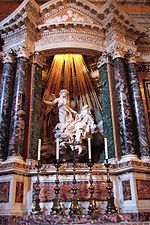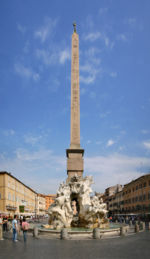- Angels & Demons
-
This article is about the novel Angels and Demons. For the movie, see Angels & Demons (film). For other uses, see Angels & Demons (disambiguation).
Angels & Demons 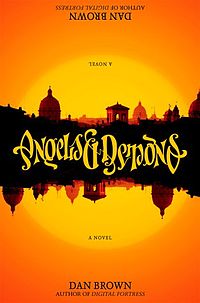
First edition coverAuthor(s) Dan Brown Country United States
United KingdomLanguage English Genre(s) Mystery, thriller fiction Publisher Pocket Books Publication date May 2000 Media type Print (Hardback and Paperback) Pages 480 ISBN ISBN 0-671-02735-2 (US) / 9780552160896(UK) OCLC Number 52990309 Dewey Decimal 813/.54 21 LC Classification PS3552.R685434 A82 2000 Preceded by Digital Fortress Followed by Deception Point Angels & Demons is a 2000 bestselling mystery-thriller novel written by American author Dan Brown and published by Pocket Books. The novel introduces the character Robert Langdon, who is also the protagonist of Brown's subsequent 2003 novel, The Da Vinci Code, and 2009 novel, The Lost Symbol. It also shares many stylistic literary elements with its sequel, such as conspiracies of secret societies, a single-day time frame, and the Catholic Church. Ancient history, architecture, and symbolism are also heavily referenced throughout the book. A film adaptation was released on May 15, 2009, though it was set after the events of The Da Vinci Code film, which had been released in 2006.
Contents
Background
The book contains several ambigrams created by real-life typographer John Langdon.[1] Besides the "Angels And Demons" and "Illuminati" designs, the title of the book is also presented as an ambigram on the hardcover book jacket (see illustration at right on this page), and on the inside cover of the paperback versions. The book also contains ambigrams of the words Earth, Air, Fire, and Water, which has served to bring the art of ambigrams to public attention by virtue of the popularity of the book.[2] The "Illuminati Diamond" mentioned in the book is an ambigram of the four elements arranged in the shape of a diamond.
Plot
The plot follows Harvard symbologist Robert Langdon, as he tries to stop the Illuminati, a legendary secret society, from destroying Vatican City with the newly discovered power of antimatter.
CERN director Maximilian Kohler discovers one of the facility's physicists, Leonardo Vetra, murdered. His chest is branded with an ambigram of the word "Illuminati". Kohler contacts Robert Langdon, an expert on the Illuminati, who determines that the ambigram is authentic. Kohler calls Vetra's adopted daughter Vittoria to the scene, and it is ascertained that the Illuminati have stolen a canister containing antimatter — a substance with destructive potential comparable to a small nuclear weapon. When at CERN the canister is stored in a unique electrical charger which ensures the anti-matters stability but when removed its back-up battery provides power for 24 hours after which the anti-matter will self-destruct. The canister is somewhere in Vatican City, with a security camera in front of it, as its digital clock counts down to the explosion.
Langdon and Vittoria make their way to Vatican City, where the Pope has recently died. It is discovered that the four Preferiti, cardinals who are the most likely papal successor, are missing. Langdon and Vittoria search for the Preferiti in hopes that they will also find the antimatter canister. Their search is assisted by Camerlengo Carlo Ventresca (the late pope's closest aide) and the Vatican's Swiss Guard.
Langdon attempts to retrace the steps of the "Path of Illumination", a process once used by the Illuminati as a means of inducting new members; aspirants to the order were required to follow a series of subtle clues left in various landmarks in and around Rome. The clues indicate the secret meeting place of the Illuminati. Langdon sets off on the Path of Illumination in hopes of delivering the Preferiti and recovering the antimatter canister.
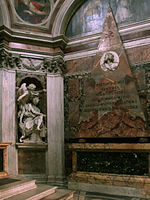 Bernini's Habbakuk and the Angel, and Agostino Chigi's pyramidal wall tomb.
Bernini's Habbakuk and the Angel, and Agostino Chigi's pyramidal wall tomb.
The Path leads Langdon to four locations in Rome, each associated with one of the primordial elements: 'Earth', 'Air', 'Fire', and 'Water'. Langdon finds one of the Preferiti murdered in a way thematically related to each location's related element. The first cardinal was branded with an Earth ambigram and had soil forced down his throat; the second was branded with an air ambigram and had his lungs punctured; the third was branded with a fire ambigram and was burned alive; and the fourth was branded with a water ambigram and was left to drown at the bottom of a fountain.
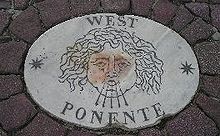 West Ponente at Saint Peter's Square.
West Ponente at Saint Peter's Square.
After finding the bodies of the first two Preferiti, Langdon hurries to the Santa Maria della Vittoria Basilica and finds the Preferiti's abductor in the act of setting the third cardinal on fire. The kidnapper is an unnamed assassin who is working under the orders of the Illuminati master "Janus", whose true identity is unknown. Commander Olivetti is killed and the assassin kidnaps Vittoria. Langdon escapes and accosts the assassin at the final element's landmark (Water), but is unable to save the cardinal.
Langdon must complete the Path of Illumination in order to find the assassin and rescue Vittoria. His search leads him to Castel Sant'Angelo, that hides a tunnel leading directly into the pope's chambers in the Vatican. Langdon frees Vittoria, and together they send the assassin falling several hundred feet to his death. The two hurry back to St. Peter's Basilica, where they find that Kohler has arrived to confront the camerlengo in private. Langdon and Vittoria fear that Kohler is Janus, and that he has come to murder the camerlengo. Hearing the camerlengo scream in agony from being branded with the Illuminati Diamond, the Swiss Guards burst into the room and open fire on Kohler. Just before he dies, Kohler gives Langdon a videotape that he claims will explain everything.
With time running out, the Swiss Guard evacuates the Basilica. The camerlengo rushes back in, claiming that he has received a vision revealing the location of the antimatter canister. With Langdon in pursuit, the camerlengo ventures into the catacombs and finds the canister sitting atop the tomb of Saint Peter. Langdon and the camerlengo retrieve the antimatter and get in a helicopter with only minutes to spare. The camerlengo manages to parachute safely onto the roof of St. Peter's just as the canister explodes harmlessly in the sky. The crowd in St. Peter's Square look in awe as the camerlengo stands triumphantly before them. Because of this "miracle", the papal conclave debate whether to elect the camerlengo as the new Pope. Langdon managed to survive the explosion by using a window cover from the chopper as a parachute, and landed in the Tiber River.
After viewing Kohler's tape Langdon, Vittoria, and the cardinals confront the camerlengo; Shortly before the beginning of the novel, the Pope met with Leonardo Vetra who believed that anti-matter was capable of establishing a link between Man and God. Vetra's beliefs caused great discomfort to the camerlengo. While discussing Vetra, the pope reveals that his support is due to science having given him a son. Without waiting to hear the explanation (that the child was the result of artificial insemination), and horrified that the Pope appeared to have broken his vow of chastity, the camerlengo plots to "rectify" the situation. He poisoned the pope and, under the guise of an Illuminati master (Janus), he recruited the assassin, to kill Vetra, steal the antimatter, and kidnap and murder the Preferiti. The Camerlengo planted the antimatter in St. Peter's in order to be seen as the savior of Christendom. The Illuminati "involvement" was merely a plot engineered by the camerlengo to cover his own plans. It is revealed that Camerlengo Ventresca himself was the birth son of the late pope, conceived through artificial insemination. Overcome with guilt Ventresca soaks himself in oil and immolates himself before a crowd of onlookers in St. Peter's Square.
Characters
See also: List of characters in Angels & Demons- Robert Langdon: A professor of symbology at Harvard University and the main protagonist of the novel. He is flown to CERN to help investigate the murder of Leonardo Vetra. He is described as wearing a pair of chino pants, turtleneck, and tweed jacket. His name is a tribute to John Langdon.
- Leonardo Vetra: A scientist working at CERN and a priest. He is researching on antimatter when he is murdered by the Assassin. He is also the adoptive father of Vittoria.
- Vittoria Vetra: The adopted daughter of Vetra. She, like her father, works with CERN. Her research focuses on biology and physics. The reader learns early in the novel that Vittoria worked with her father in their research of antimatter.
- Camerlengo Carlo Ventresca: The Camerlengo (Papal Chamberlain) during the conclave. He murdered the pope, who is later revealed to have been his biological father. His codename for dealing with the assassin, "Janus", was taken from the two-faced Roman god of beginnings and ends, and for whom the month of January was named.
- Cardinal Saverio Mortati: The most senior cardinal in the conclave, and the current Dean of the College of Cardinals. He was the Devil's Advocate for the late pope.
- Commander Olivetti: The commandant of the Swiss Guard. He is initially skeptical on the claims of Langdon and Vittoria until he talks with the Hassassin. He, along with other Swiss Guards, search desperately for the missing antimatter hidden somewhere at the Vatican. He is killed by the Hassassin at the church of Santa Maria della Vittoria.
- Captain Rocher: The second in command after Commander Olivetti. He is contacted by Max Kohler telling his knowledge on the real cause of the events. He is killed by Lt. Chartrand, who was under the impression that Rocher was an Illuminatus.
- Hassassin: The killer hired by Janus, the Camerlengo in disguise, to fulfill his plans. He is of Middle Eastern origin and displays his sadistic lust for women throughout the novel. He murders Leonardo Vetra, the Preferiti, and Commander Olivetti. He dies after being pushed from a balcony by Langdon at the Castel Sant'Angelo and breaking his back on a pile of cannonballs below.
- Maximilian Kohler: The director of CERN. He is feared at CERN despite his paralysis. His wheelchair contains electronic gadgets such as a computer, telephone, pager, video camera, and a gun. He contacts Langdon to help him find the killer of his friend, Leonardo Vetra. He blames the Church for his paralysis, due to his highly religious parents denying him medical care as a child, becoming a scientist as a way to rebel.
- Gunther Glick and Chinita Macri: A reporter and his photojournalist for the BBC. They are contacted by the Hassassin regarding the events happening in the Vatican. Glick has a notorious reputation as a sensationalist and conspiracy theorist journalist. Macri, meanwhile, is a veteran camera crew and a foil to Glick. They have the first-hand account on the events in the novel, from the beginning of the conclave to the election of Mortati as pope.
- Lieutenant Chartrand: A young Swiss Guard. He, together with Commander Olivetti and Capt. Rocher, search desperately for the antimatter hidden somewhere in the Vatican. He shoots and kills Captain Rocher after he is mistaken as an Illuminatus. Near the end of the novel, he is sent by the new pope to give the Illuminati Diamond as an indefinite loan to Langdon.
- Cardinal Ebner: One of the four Preferiti and a cardinal from Frankfurt, Germany. He is killed by asphyxiation, by means of putting dirt and soil into his mouth.
- Cardinal Lamassé: One of the four Preferiti and a cardinal from Paris, France. He is killed by punctures to his lungs, from which he bled to death.
- Cardinal Guidera: One of the four Preferiti and a cardinal from Barcelona, Spain. He is incinerated alive.
- Cardinal Baggia: One of the four Preferiti and a cardinal from Milan, Italy and the favorite to succeed as the new pope. He was drowned to death.
Inaccuracies
The book's first edition contained numerous inaccuracies of location of places in Rome, as well as incorrect uses of Italian language. Some of the language issues were corrected in the following editions.[3]
Aside from the explicit introduction, the book depicts various fictional experts explaining matters in science, technology, and history in which critics have pointed out inaccuracies. An example of this is the antimatter discussions, wherein the book suggests that antimatter can be produced in useful and practical quantities and will be a limitless source of power. CERN has published a FAQ on Angels and Demons, stating that antimatter cannot be used as an energy source because creating it takes more energy than it produces.[4]
Angels & Demons Decoded, a documentary on an American cable television network, The History Channel, premiered on May 10, 2009, shortly before the release of the novel's film adaptation. The documentary explores the various bases of the novel's story, as well as its inaccuracies. A CERN official, for example, points out that over the last 20 years, approximately 10 billionths of a gram of antimatter has been produced at the facility, whose explosive yield is equivalent to that of a firecracker, far less than is needed for it to be the threat depicted in the novel.[5]
Foreign language editions
The following is a list of foreign language editions of the novel. Those with a link go to the article on the novel on that language's Wikipedia. Foreign language Wikipedias that feature an article on the novel but in which an edition of the novel was not printed are not listed here, but in the sidebar to the left of the article. Editions that feature the title "Angels & Demons" on the cover in both English and in that foreign language indicate this in parenthesis.
- Engjej dhe djaj - Albania[6]
- Шестото клеймо - Bulgarian[6]
- Angels i dimonis - Catalan[6]
- 天使与魔鬼 (Angels & Demons) - Chinese[6]
- Andělé a démoni - Czech[6]
- Engle & Dæmoner - Danish[6]
- Het Bernini Mysterie - Dutch[7]
- Enkelit ja demonit - Finland[6]
- Anges & Démons - France[6]
- Anxos e demos - Galician[6]
- Illuminati - German[6]
- Illuminati (Πεφωτισμένοι) - Greek[6]
- מלאכים ושדים - Hebrew[6]
- Angyalok és démonok - Hungarian[6]
- Englar & Djöflar - Icelandic[6]
- Angeli e Demoni - Italian[6]
- 天使と悪魔 - Japanese[6]
- Malaikat dan Iblis - Indonesian[6]
- 천사와 악마 - Korean
- Eņģeļi un Dēmoni - Latvian[6]
- Ангели и демони - Macedonian[8]
- Engler & Demoner - Norwegian[6]
- Anioły i demony - Polish[6]
- Anjos e Demonios - Portuguese[6]
- Îngeri şi demoni - Romanian[6]
- Anjeli a démoni - Slovakia[6]
- Angeli in Demoni - Slovenia[6]
- Ángeles y demonios - Spanish[6]
- Änglar och Demoner - Swedish[6]
- เทวากับซาตาน (Angels & Demons) - Thai[6]
- Melekler ve Şeytanlar - Turkish[6]
See also
- Draper–White thesis
- Particle accelerators in popular culture
Notes
- ^ www.johnlangdon.net Official website of John Langdon, section "Angels & Demons" (retrieved January 30, 2007)
- ^ "The Ten Most Famous Ambigrams". Ambigram Magazine (Ambigram.com). http://www.ambigram.com/most-famous-ambigrams.
- ^ "Gialli & Thriller:ANGELI E DEMONI di Dan Brown". Leggiamo.altervista.org. http://leggiamo.altervista.org/thriller_angeliedemoni.htm. Retrieved 2011-10-20.
- ^ "CERN - Spotlight: Angels and Demons". CERN - European Organization for Nuclear Research. Archived from the original on January 29, 2008. http://web.archive.org/web/20080129234743/http://public.web.cern.ch/Public/en/Spotlight/SpotlightAandD-en.html. Retrieved September 11, 2008.
- ^ Angels & Demons Decoded at History.com
- ^ a b c d e f g h i j k l m n o p q r s t u v w x y z aa ab Angels & Demons World Editions at Dan Brown's official site
- ^ "''Het Bernini Mysterie''". Uitgeverijluitingh.nl. http://www.uitgeverijluitingh.nl/component/option,com_books/task,book/id,4323/Itemid,3/. Retrieved 2011-10-20.
- ^ "Angels and Deamons, Dan Brown (Macedonian edition)". Kniga.com.mk. 2009-02-17. http://www.kniga.com.mk/default.aspx?pArtID=116&pDetail=Y. Retrieved 2011-10-20.
References
- Burstein, Dan (ed). Secrets of Angels & Demons: The unauthorized guide to the bestselling novel, 2004, CDS Books. ISBN 1-59315-140-3, Collection of many essays by world-class historians and other experts, discussing the fact & fiction of the novel
- Angels and Demons Draws Tourists to Rome, January 20, 2005, NPR
- CERN's own page about fact and fiction in the novel
- Angels and Demons Movie News Site
- Path of Illumination (with photos of the places of Angels & Demons)
- Dan Brown's own page
- Book 'Antimatter, The Ultimate Mirror' ISBN 978-0-521-89309-1
External links
- Vatican Bans filming the movie in churches
- Articles and term paper about Adam Weishaupt and the historic illuminati... (english/german)
- Wikibooks
- Dan Brown Official Website
- Dan Brown Official UK Website
- Dan Brown Official Australian Website
Characters Organizations Media Places Novels Digital Fortress (1998) • Angels & Demons (2000) • Deception Point (2001) • The Da Vinci Code (2003) • The Lost Symbol (2009)Film adaptations The Da Vinci Code (2006) • Angels & Demons (2009) • The Lost Symbol (2012)Related articles Categories:- 2000 novels
- Angels & Demons
- Christian fiction and allegory
- Crime novels
- Novels by Dan Brown
- Techno-thriller novels
- Novels about elections
- Vatican City in fiction
- American thriller novels
- 21st-century American novels
Wikimedia Foundation. 2010.

